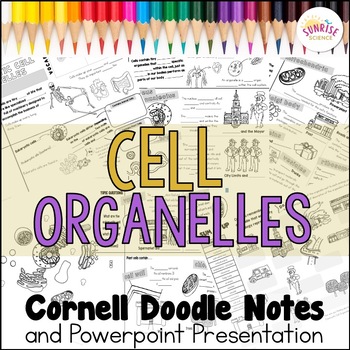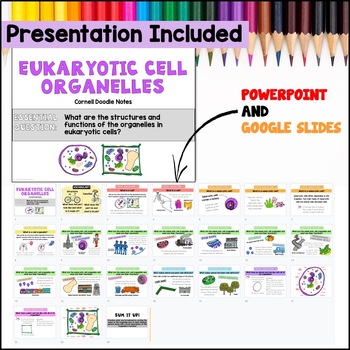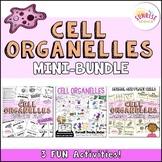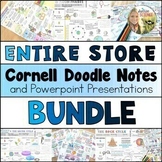Cell Organelles Doodle Notes Animal and Plant Cells City Analogy
What educators are saying
Also included in
- Try this Cell Organelles Activity Bundle if you are looking for fun and engaging ways to teach the Cell Organelles' structure and function!This is a mini-bundle containing three products to help you teach the structures and functions of the Cell Organelles. Save 20% on these three activities!:a visuPrice $9.00Original Price $11.28Save $2.28
- This is a growing bundle of ALL of my Science Cornell Doodle Notes resources. This bundle currently contains Cornell Doodle Notes and the associated Powerpoint / Google Slides Presentations for 48 science topics. The price at this point reflects what is in the bundle at this time, plus 20% off. As aPrice $189.00Original Price $244.25Save $55.25
Description
These Cell Organelles Cornell Doodle Notes are a visual, scaffolded, no-prep resource for teaching about the structure and function of eukaryotic cell organelles and the difference between animal and plant cells! These notes cover the general definition of a eukaryotic cell (contains a nucleus), gives a city analogy for each of the main cell organelles (for example, power plant = mitochondria, nucleus = city hall, ribosomes = businesses, etc.), and differentiates between animal and plant cells (cell wall and chloroplasts). Each ‘city’ analogy drawing is accompanied by a drawing of the organelle itself and a short description of the function of that organelle.
On the last 3 pages of the notes, students will label the organelles of an animal cell and a plant cell, and then they will recall the functional analogy (for example, the nucleolus is like the mayor and the vesicles are like mail trucks, etc.) for each of the organelles.
These 7-page, scaffolded notes can be used as part of the input for NGSS MS-LS1-2 (Disciplinary Core Idea: Students who demonstrate understanding can: Develop and use a model to describe the function of a cell as a whole and ways parts of cells contribute to the function; Crosscutting Concept: Complex and microscopic structures and systems can be visualized, modeled, and used to describe how their function depends on the relationships among its parts, therefore complex natural structures/systems can be analyzed to determine how they function.)
These scaffolded Cornell Doodle Notes combine two effective note-taking strategies:
Cornell Notes are a note-taking strategy in which topic questions are written in a narrow left-hand column and definitions, explanations, and diagrams are filled in in the right-hand column.
Doodle Notes are another note-taking strategy for which pictures and graphics activate the visual pathways of the brain, which helps with retention of information when compared to standard note-taking. Your visual learners will really benefit from seeing and coloring in the pictures aside the main points of the notes!
What's Included (please see the preview also!):
- The Cornell Doodle Notes are 7-pages each and there are 3 scaffolded versions plus the answer key
- Two presentation options: Powerpoint AND Google Slides
- Google Slides version of the notes with student directions and Google Tools and Fonts sidebar
Here are some things to know about Cornell Doodle Notes:
✓ A Powerpoint comes with these notes, and it is also available as a Google Slides presentation so that you can opt to share it with your students via Google Classroom
✓ These notes include a Sum It Up page to help students engage further with the vocabulary and concepts in the notes
✓ There are three scaffolded versions included that contain the same content but different amounts of writing for the student
✓ Packed with visuals, examples, and analogies for brain-friendly learning
✓ No prep other than printing out the scaffolded note versions and sharing the Google link if necessary
✓ Easy to leave for a substitute
✓ Fun for students to color, which will help to aid retention of the content
✓ Supplements three-dimensional learning with rich content
Here are some ways that I suggest using this resource:
✎ Whole-Group lesson with scaffolding : Decide which students should receive which level of the notes. Hand out the notes to the students. Use the Powerpoint or Google Slides as a presentation and talk aloud through the lesson while the students take notes OR If you have a document camera (an ELMO), you can fill out your own notes and the students can follow along with you as you discuss the concepts aloud! Stop throughout the lesson to have the students pair-share and discuss what they are learning. Allow them to color/doodle further during and at the end of the lesson.
✎ Scaffolded Small-Group lesson : Separate your students into groups by learning level. Give each student group sets of the appropriate notes for their level. Make sure each group has a device to view the presentation. Post the Powerpoint or Google Slides to your Google Classroom or other online learning platform, or email the Powerpoint version to one ‘student leader’ in each group. The students would view the Powerpoint/Slides together on one device and fill in the notes. Encourage them to add color/further notes.
✎ Individual Note-Taking or Flipped Classroom : Post the Powerpoint or Google Slides presentation to your Google Classroom or other online learning platform. Hand out the appropriate-level notes to each student. Students can work at their own pace to view the presentation and complete their notes. Encourage them to add color/further notes. Could also be assigned for homework or as a “half & half lab” for which one group of students is taking notes at their desks while another group is performing a lab.
✎ Distance Learning Scenario: Create a screencast lecture using one of the presentation options, or you could record audio clips over each slide that your students will play as they view the presentation.
Options for Digital Note-taking:
- Assign the Google Slides version of the notes (please view the Preview to get a better idea of what this version looks like!)
- Assign this resource using TPT's Easel Digital Activity Tool
- Assign these notes digitally using the Kami Extension for Google Classroom. Learn about this option by downloading THIS FREEBIE!
Please note that this resource is not editable due to font and clip art licensing agreements and also to protect my work. However, you can always add additional text boxes to the presentation, as well as insert new slides with images/text/video clips, etc. to customize the lesson for you and your students!
Doodle notes is a trademarked term used with permission. Please visit doodlenotes.org for more information.
You may also be interested in these resources:
Cell Organelles Play to Act Out the Functions of an Animal Cell
Cell Organelles City Analogies Memory Matching Game
Microscope Cornell Doodle Notes and Powerpoint
Photosynthesis Cornell Doodle Notes and Powerpoint
✨ Save 25% off by purchasing this resource within the Entire Store of Cornell Doodle Notes Bundle!
Thanks for looking!
Sunrise Science







